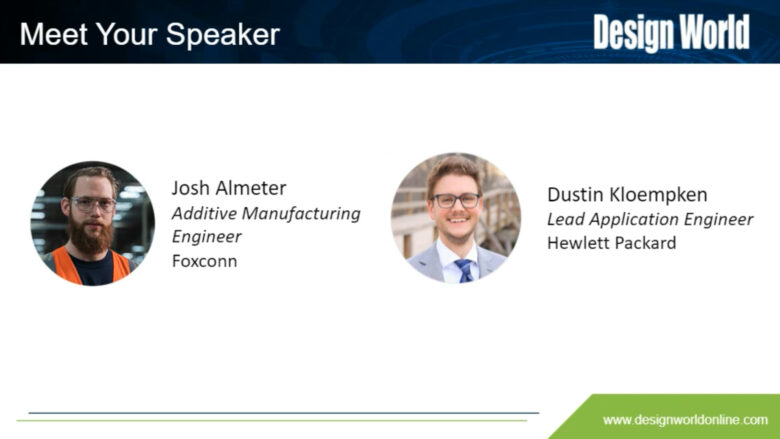Additive technologies throw a wrench in traditional manufacturing but can save millions of dollars and minutes down the line. Still, many organizations hesitate and view 3D printing anything besides prototypes as costly and unnecessary.
Maybe it’s time to think differently and more creatively.
In a recent webinar, Dustin Kloempken, a lead application engineer at HP, explained how 3D printing has changed the way HP employees view problems and approach solutions. Some years ago, HP asked Foxconn to help with internal processes, such as putting ink cartridges into boxes. In the fall of 2017, Josh Almeter, a manufacturing project engineer at Foxconn, started using an HP Multi-Jet Fusion (MJF) 4200 printer and actively sought opportunities to use the technology. Soon, employees began asking him how they might use MJF to improve their parts and processes.

In 2018, Almeter used MJF primarily for conveyor parts, automation, and jigs and fixtures for packaging or assembly operations. But in 2022, maintenance requests increased significantly in MJF usage, signifying a shift in how employees approached problems. Almeter estimated that the company saved $100,000 in parts and gained $40,000 in external sales by 3D printing about 7,000 parts. He noted that about one-third of the estimated savings were achieved in 2022 alone.
“If you’re jumping into this technology, it is a different manufacturing process — a different mindset shift — and it takes a while to wrap your head around that to really start getting those savings and knowing how and where it makes sense,” said Kloempken.
Kloempken explained the three main reasons why Almeter found such success:
- Learning from other applications and approaches
- Taking on engineering projects and solving problems
- Educating and encouraging departments to use the technology
“Now, Josh isn’t looking at where we can use 3D printing. It’s more about what problems we have in the organization and how we can solve them differently and creatively,” said Kloempken.
He also described an application where HP printed more than 190,000 parts and avoided more than $11 million in cost-related issues.
Almeter started his 3D printing journey with fused deposition modeling (FDM), but the technology didn’t fulfill many of his organization’s projects and needs. After much research, he switched to MJF for its high capacity and high-quality parts at a particular price range.
“It was a steep learning curve, even coming from FDM. The technologies are totally different. The way you design parts, the way you set up builds, the way you process parts — everything is completely different,” said Almeter.
But it wasn’t just his learning curve; it was also the learning curve of everyone else in the company that he had to face.
“In the beginning, most maintenance technicians didn’t even believe that a 3D-printed part could do anything,” said Almeter. “I think that is partly because most people’s exposure is only to FDM parts that are mostly for prototyping and visuals. But now we have a printer that can make final, end-use parts that are strong.”
It took a while to get everyone on board, and Almeter received zero requests from maintenance personnel initially. But in time, technicians started coming to Almeter and admitted that the parts he created made their jobs easier. The company also found ways to use 3D printing that they didn’t expect.

Ultimately, “the juice was worth the squeeze,” as Kloempken put it.
To avoid stealing the experts’ thunder in this article, watch the webinar recording for the complete story and some Q&A from other engineers: Scaling Your Business with Additive Manufacturing.
Filed Under: Make Parts Fast




